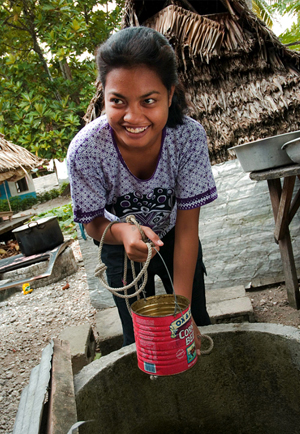Kiribati's fragile atoll environment means that the only sources of fresh water are from underground lenses and rainwater. In South Tarawa, the country's capital, most lenses are highly polluted due to overcrowding and lack of proper sanitation facilities.
Around 50,000 people – almost half of Kiribati's total population – live on South Tarawa's land area of 15.76 square kilometres. This makes for a population density of 3,184 per square kilometre with some areas, such as Betio, having densities as high as 10,610. With such a large number of people living in such a small place, the population density is actually higher than in Tokyo.
The combination of inadequate fresh water supplies and degraded sanitation systems is having a devastating impact on the population. For every 1,000 children born, 46 are dying before their fifth birthday – compared with just five in Australia. This is largely a result of two to three outbreaks of acute diarrheal disease occurring in South Tarawa every year due to the extremely high incidence of water-borne disease.
"In order to reduce preventable deaths of children, clean water, sanitation and hygiene are three vital issues that AusAID will be assisting Kiribati with," said Ms Lydia Bezeruk, AusAID First Secretary in Kiribati.
Australia's $13.9 million support towards a sanitation program in South Tarawa aims to provide the community with better sanitation services. The program will rehabilitate existing sewerage systems, and upgrade saltwater flush systems for toilets to conserve and protect South Tarawa's scarce groundwater resources from overuse and pollution.
Australia will also install rainwater harvesting systems to ensure cleaner, safer drinking water, reduce water leakages and waste in existing systems, and help the Government of Kiribati protect water reserves.
These changes are expected to halve the number of children aged up to five years old dying from diarrhoea every year.

